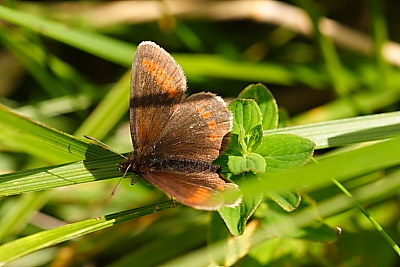
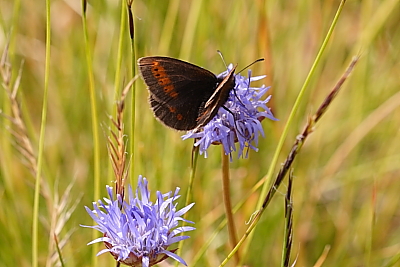
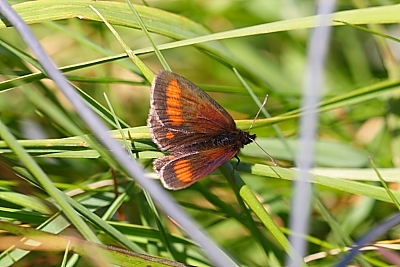
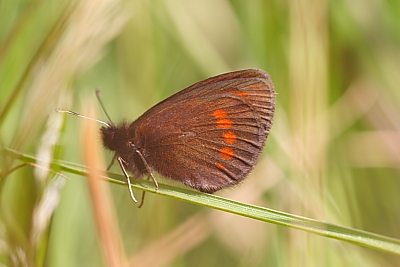
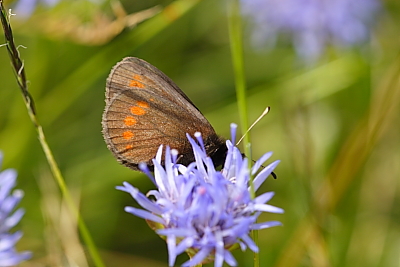
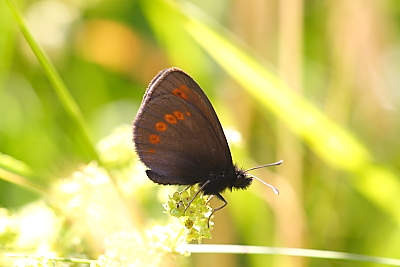
Sudeten Ringlet (Erebia sudetica)
2024 photographs highlighted in yellow. Click on any photograph to go to an enlarged picture, or simply scroll down the page.
 |
 |
 |
 |
| 18638_male_Isère_15Jul09 | 38502_male?_Cantal_13Jul15 | 38528_male_Cantal_14Jul15 | 38489_male?_Cantal_13Jul15 |
 |
 |
||
| 38499_male?_Cantal_13Jul15 | 38534_female?_Cantal_14Jul15 |
|
Sudetica is a species of the Carpathians (which presumably gives it its name), the Grindelwald region of Switzerland, and certain isolated locations in France including Savoie, Isère and Cantal. The Savoie and Isère populations are not mentioned in H&R, but are in T&L, so probably these populations were not known at the time of publication of H&R (1970), given that the authors were particularly thorough with regard to locations.
According to Lafranchis, the subspecies that occurs in Savoie and Isère is belladonnae whereas the Cantal subspecies is lioranus (stated as liorana in H&R and T&L). However, Lafranchis does not give any description of the differences between these two subspecies. T&L says that lioranus occurs in all the French localities.
The key identifying feature of the nominate form (which does not occur in France) appears to be that the upf red post-discal band is comprised of four or five red marks in regular series, and the unh has six spots that are "conspicuously regular" (according to H&R). It says that the mark in s3 is often slightly larger than those adjacent, and that each mark usually encloses a small black point. H&R says that lioranus is less bright and the uph series reduced to four marks and the unh series four or five marks but still in regular series. |
It was certainly my experience in the Cantal in 2015 that the unh had a series of rounded, often very well rounded, red post-discal marks. These features were a stand-out and made them almost impossible to confuse with any other Erebia species.
The black centres, if present, are weak, with the female being slightly better marked than the male in this respect. Whether this applies equally to the uph is not clear.
I have seen what I believe is belladonnae in Isère in 2009, but did not realise it at the time (see comments on 18638 below). In 2015 I visited the known locations in Cantal, three separate spots, and saw numerous sudetica there, all of the subspecies lioranus. However, in the high winds it was almost impossible to get any passable photographs as, when they did settle, it was always deep in the grass.
It is superficially very similar to the Mountain Ringlet (E. epiphron) and to a lesser extent to the Lesser Mountain Ringlet (E. melampus).
|
|
ref |
sex |
observations |
alt. m |
|
18638 |
M |
I originally had this down as epiphron although was never entirely convinced. On a review in 2015, I began to wonder whether this could be sudetica and sought the views of Guy Padfield and Matt Rowlings who were familiar with sudetica in Switzerland. Guy thought it could be either, with perhaps epiphron as default, sudetica being highly localised in France. I then received Matt's response saying that it looked very much like the sudetica he had seen at (by pure chance) exactly the same location as I had seen 18638. This evidence may be circumstantial but it is highly persuasive, so I have included 18638 on this page to invite comment. |
1850 |
|
38502 |
M |
I thought this was a male at the time, but the black points in the post-discal band suggest female. |
1820 |
|
38528 |
M |
a male. |
1650 |
|
38489 |
M |
a male, with a very regular series of very round red unh marks in s3-6 with a vestigial mark in s2. |
1820 |
|
38499 |
M |
another male, the unh marks being less distinctive than 38489. |
1820 |
|
38534 |
F |
probably a female based on body shape and the black centres to the unh post-discal marks. |
1650 |